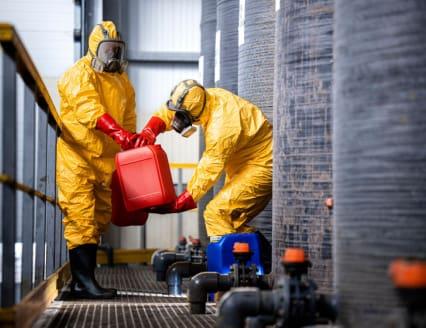What are Dangerous Substances and Explosive Atmospheres Regulations (DSEAR)?
The Dangerous Substances and Explosive Atmospheres Regulations (DSEAR) 2002 is a UK legislation that applies to any workplace where flammable substances are present. It requires employers to inspect the premises regularly, assess all potential risks from hazardous chemicals or combustibles in the workplace, report accidents and incidents, and draw up emergency plans. Moreover, it also includes training obligations for everyone working with hazardous materials. Employers are expected to do their utmost to ensure all regulations are met at all times to safeguard their employees and property.
How Do COSHH and DSEAR Differ?
DSEAR and Control of Substances Hazardous to Health Regulations (COSHH) Regulations 2002 require employers to assess and control the hazards associated with handling, storing, using, and transporting hazardous materials. Here’s how they differ.
DSEAR places certain obligations upon employers to protect employees and the public from dangerous substances.
COSHH, conversely, ensures the safe use and control of hazardous substances. Employers are required to ensure that anyone attending their worksite is protected from substances that could be harmful to their health.
What are Considered Dangerous Substances?
Managing hazardous substances in explosive atmospheres reduces the risk of fires and explosions for employees and the public. DSEAR compliance requires the elimination or control of these risks.
Many dangerous substances include flammable gases, mists, vapors, and combustible dust. There are several examples found in workplaces, including:
- Solvents
- Paint
- Flammable gases
- Dust from machining and sanding operations
- Dust from foodstuffs
- Pressurized gases
- Flammable liquids
Minimize Risk and Ensure DSEAR Compliance with SafetyCulture
Eliminate manual tasks and streamline your operations.
Get started for FREEWhat Does It Define as a Workplace?
Under DSEAR regulations, workplaces can encompass industrial and commercial properties, land and offshore operations, construction sites, vehicles, common areas in shared buildings, private and public roads, and domestic properties (when utilized for work).
It’s important to note that some requirements of DSEAR may not apply to specific industries within a specified area. For instance, offshore oil production would not need to comply with the regulations. If there is any uncertainty regarding whether your workplace must adhere to DSEAR regulations, it is advisable to consult a competent individual to ensure that all legal requirements are met.
When Does It Apply?
The DSEAR regulations apply to you if:
- You’re an employer (or self-employed individuals) conducting work on hazardous substances
- Your workplace contains (or is likely to hold) a dangerous substance
- People’s safety could be at risk due to fires, explosions, potentially hazardous energetic events, or metal corrosion – this can include thermal fluids and heat transfer systems
- You’re transporting flammable substances like LPG
What Does It Require of Employers?
DSEAR requires employers must do the following:
- Identify the hazardous substances in their workplace and the risks associated with them
- Control those risks either by removing them or controlling them, if possible
- Ensure that any incidents involving dangerous substances are managed to reduce their effects
- Ensure that plans and procedures are in place to deal with hazardous substance accidents, incidents, and emergencies
- Make sure employees are adequately informed and trained about dangerous substances and how to deal with them
- Locate and classify workplace areas where explosive atmospheres are likely to occur, and avoid ignition sources
Key Aspects of DSEAR
DSEAR has 5 main regulations that employers need to be aware of:
- Risk Assessment (DSEAR Regulation 5): DSEAR Regulation 5 requires risk assessments for dangerous or potentially dangerous substances in a working environment.
- Elimination or Reduction of Risks (DSEAR Regulation 6): Regulation 6 of DSEAR works to reasonably minimize the risks from dangerous substances. It entails replacing, whenever feasible, hazardous materials or processes to limit or reduce danger.
- Area of Classification (DSEAR Regulation 7): Employers must determine workplace areas where an explosive atmosphere is likely to form based on DSEAR regulations. These areas should be categorized as hazardous or non-hazardous zones.
- Incident Handling (DSEAR Regulation 8): The employer must establish procedures to prevent accidents, incidents, or emergencies related to dangerous substances, protecting the safety of their employees.
- Information Dissemination, Instruction, and Training (DSEAR Regulation 9): Employers must provide employees and emergency personnel with information and instruction regarding the safe handling of dangerous substances and regular training to ensure that they remain up-to-date.
- Identification of Hazardous Containers and Pipelines (DSEAR Regulation 10): Regulatory requirements require properly labeling containers and pipes containing hazardous substances. For the safety of employees and other people in the workplace, employers must make sure they are aware of dangerous substances present. Identification of hazardous substances is essential to prevent confusion over their contents and accidental mixing of those substances.
- Duty of Coordination (DSEAR Regulation 11): DSEAR requires employers responsible for the workplace to coordinate the implementation of measures to protect employees and others from explosive atmospheres at work.
Steps Involved in Conducting a DSEAR Risk Assessment
Performing a DSEAR risk assessment involves the following steps:
- Identify the hazards
- Evaluate existing controls
- Consider who might be harmed and how
- Record the findings of the risk assessment
- Periodically review and revise the risk assessment
FAQs About DSEAR
The DSEAR regulations are a legal requirement that employers and self-employed must follow to eliminate the risk of fires and explosions at work. DSEAR requires employers to assess all sites with hazardous environments (dangerous substa
DSEAR assessments should be updated and reviewed regularly, as with all other risk assessments and inspections. The Health and Safety Executive (HSE) generally recommends that DSEARs be updated every three to five years, depending on the risk levels of the operation.
ATEX is a set of two EU directives that describe safety requirements for explosive atmosphere work environments and equipment. Meanwhile, DSEAR is a UK law that covers both elevated temperatures and pressures. In most cases, explosive atmospheres result from combustible substances escaping unintentionally.
A DSEAR regulation implements requirements from 2 European Directives: the Chemical Agents Directive (98/24/EC) and the Explosive Atmospheres Directive (99/92/EC). It also replaced several older regulations dealing with flammable substances safety.




